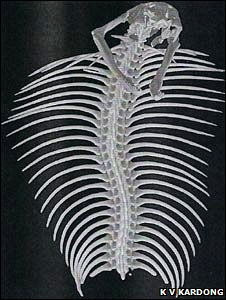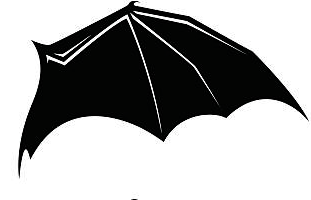Herodotus dragon. A cobra?
Several years ago I proposed that the “dragon” legend began in China, and that the original dragon was the snake that carried the Sun in its mouth across the sky each day, leading to the legend that it breathed fire. And so to this day some Chinese dragons have no wings or legs. During the night it travels under the Earth through caves back to the other side. This is a useful object lesson to children to frighten them out of exploring caves. Wings were added later for a dragon to fly through the sky, and legs later for it to crawl through caves. Earthquakes were explained as dragons moving under the Earth.
But the word “dragon”, I am told, comes from the Greek. And the ancient Greek Herodotus, who had no knowledge of China, talks of “winged serpents” of Arabia so specifically that one ought to be able to determine which extant or extinct species he’s referring to. The following two passages describe them.
“There are also about Thebes sacred serpents, not at all harmful to men, which are small in size and have two horns growing from the top of the head: these they bury when they die in the temple of Zeus, for to this god they say that they are sacred. There is a region moreover in Arabia, situated nearly over against the city of Buto, to which place I came to inquire about the winged serpents: and when I came thither I saw bones of serpents and spines in quantity so great that it is impossible to make report of the number, and there were heaps of spines, some heaps large and others less large and others smaller still than these, and these heaps were many in number. This region in which the spines are scattered upon the ground is of the nature of an entrance from a narrow mountain pass to a great plain, which plain adjoins the plain in Egypt; and the story goes that at the beginning of spring winged serpents from Arabia fly towards Egypt, and the birds called ibises meet them at the entrance to this country and do not suffer the serpents to go by but kill them. On account of this deed it is (say the Arabians) that the ibis has come to be greatly honoured by the Egyptians, and the Egyptians also agree that it is for this reason that they honour these birds. The outward form of the ibis is this:—it is a deep black all over, and has legs like those of a crane and a very curved beak, and in size it is about equal to a rail: this is the appearance of the black kind which fight with the serpents, but of those which most crowd round men’s feet (for there are two several kinds of ibises) the head is bare and also the whole of the throat, and it is white in feathering except the head and neck and the extremities of the wings and the rump (in all these parts of which I have spoken it is a deep black), while in legs and in the form of the head it resembles the other. As for the serpent its form is like that of the watersnake; and it has wings not feathered but most nearly resembling the wings of the bat.”
“Then again Arabia is the furthest of inhabited lands in the direction of the midday, and in it alone of all lands grow frankincense and myrrh and cassia and cinnamon and gum-mastich. All these except myrrh are got with difficulty by the Arabians. Frankincense they collect by burning the storax, which is brought thence to the Hellenes by the Phenicians, by burning this, I say, so as to produce smoke they take it; for these trees which produce frankincense are guarded by winged serpents, small in size and of various colours, which watch in great numbers about each tree, of the same kind as those which attempt to invade Egypt: and they cannot be driven away from the trees by any other thing but only the smoke of storax. The Arabians say also that all the world would have been by this time filled with these serpents, if that did not happen with regard to them which I knew happened with regard to vipers: and it seems that the Divine Providence, as indeed was to be expected, seeing that it is wise, has made all those animals prolific which are of cowardly spirit and good for food, in order that they may not be all eaten up and their race fail, whereas it has made those which are bold and noxious to have small progeny. … Just so also, if vipers and the winged serpents of the Arabians were produced in the ordinary course of their nature, man would not be able to live upon the earth; but as it is, when they couple with one another and the male is in the act of generation, as he lets go from him the seed, the female seizes hold of his neck, and fastening on to it does not relax her hold till she has eaten it through. The male then dies in the manner which I have said, but the female pays the penalty of retribution for the male in this manner:—the young while they are still in the womb take vengeance for their father by eating through their mother, and having eaten through her belly they thus make their way out for themselves. Other serpents however, which are not hurtful to man, produce eggs and hatch from them a very large number of offspring. Now vipers are distributed over all the earth; but the others, which are winged, are found in great numbers together in Arabia and in no other land: therefore it is that they appear to be numerous.”
“The trees which produce frankincense” grow in southern Oman on the Arabian peninsula. From the web, “The most common species in Oman include the Arabian cobra, Saw-scaled viper, puff adder, wadi racer, tree snakes, sand viper, sand boa and the cat snake.”
“The Arabian Cobra Naja arabica, is an elusive species and rarely seen in the wild.” It is now found only in southern Oman, Yemen, and western Saudi Arabia.
Four species are described in these two passages by Herodotus.
The African Sacred Ibis, aka Bin Chicken. Threskiornis aethiopicus “the head is bare and also the whole of the throat, and it is white in feathering except the head and neck and the extremities of the wings and the rump (in all these parts of which I have spoken it is a deep black),”
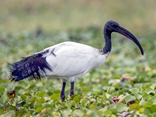
Extant range

The glossy ibis. Plegadis falcinellus. “it is a deep black all over, and has legs like those of a crane and a very curved beak, and in size it is about equal to a rail”.
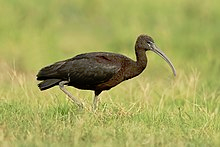
Extant range

The horned viper. Cerastes cerastes. “serpents, not at all harmful to men, which are small in size and have two horns growing from the top of the head”.

Extant range

Flying snake. Species ?. “the serpent its form is like that of the watersnake; and it has wings not feathered but most nearly resembling the wings of the bat … these storax trees which produce frankincense are guarded by winged serpents, small in size and of various colours, which watch in great numbers about each tree, of the same kind as those which attempt to invade Egypt”.
Arabian cobra?

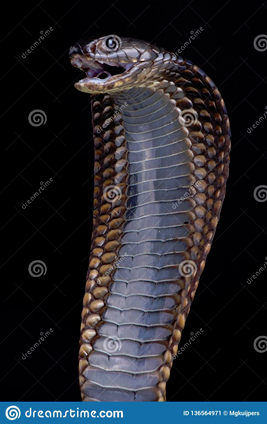
Herodotus saw dismembered skeletons of these snakes, not live snakes. “I saw bones of serpents and spines in quantity so great that it is impossible to make report of the number, and there were heaps of spines”.
Left, correct interpretation of spines. Right, misinterpretation of spines.
